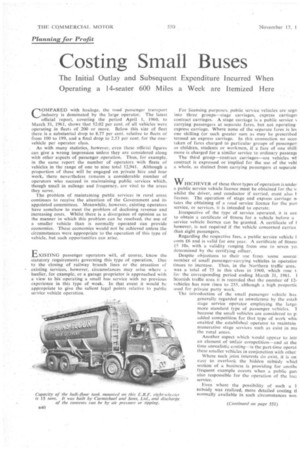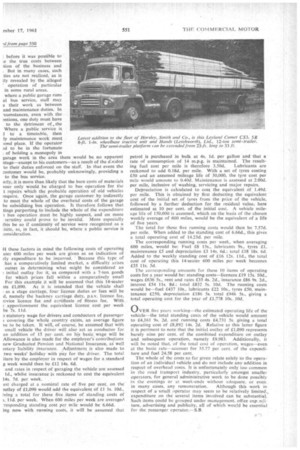Planning for Profit
Page 74

Page 77

If you've noticed an error in this article please click here to report it so we can fix it.
Costing Small Buses
The Initial Outlay and Subsequent Expenditure Incurred When Operating a 14-seater 600 Miles a Week are Itemized Here
COMPARED with haulage, the road passenger transport industry is dominated by the large operator. The latest official report, covering the period April 1, 1960, to March 31, 1961, shows that 52.02 per cent, of all vehicles were operating in fleets of 200 or more. Below this size of fleet there is a substantial drop to 8.77 per cent, relative to fleets of from 100 to 199, and a final drop to 2.53 per cent. for the onevehicle per operator class.
As with many statistics, however, even these official figures can give a wrong impression unless they are considered along with other aspects of passenger.operation. Thus, for example, in the same report the number of operators with fleets of vehicles in the range of one to nine total 12,941. Although a proportion of these will he engaged on private hire and tour work, there nevertheless remains a considerable number of operators who succeed in maintaining public services which. though small in mileage and frequency, are vital to the areas they serve.
The problem of maintaining public services in rural areas continues to receive the attention of the Government and its appointed committees. Meanwhile, however, existing operatorshave somehow to meet the problem of declining revenue and increasing costs. Whilst there is a divergence of opinion as to the manner in which this problem can be resolved, the use of a smaller vehicle than is normally operated can provide economies. These economies would not be achieved unless the circumstances were appropriate to the operation of this type of vehicle, but such opportunities can arise.
EXISTING passenger operators will, of course, know the statutory requirements governing this type of operation. Due to the closing of railway branch lines or the cessation of existing services, however, circumstances may arise where a haulier, for example, or a garage proprietor is approached with a view to his operating a small bus service with no previous experience in this type of work. In that event it would be appropriate to give the salient legal points relative to public service vehicle operation.
For licensing purposes, public service vehicles are segn into three groups—stage carriages, express carriages contract carriages. A stage carriage is a public service carrying passengers at separate fares, but not operating express carriage. Where none of the separate fares is les one shilling (or such greater sum as may be prescribed termed an express carriage. In this connection no acco taken of fares charged to particular groups of passenger: as children, students or workmen, if a fare of one shilli more is charged for a similar service to ordinary passeng< The third group—contract carriages—are vehicles wf contract is expressed or implied for the use of the vehi a whole, as distinct from carrying passengers at separate
WHICHEVER of these three types of operation is under a public service vehicle licence must be obtained for the v. whilst the driver, and conductor if carried, must also !licence. The operation of stage and express carriage n. tates the obtaining of a road service licence for the pan service, or services, it is intended to operate.
Irrespective of the type of service operated, it is nee to obtain a certificate of fitness for a vehicle before a service vehicle licence can be granted. A certificate of however, is not required if the vehicle concerned carries than eight passengers.
Regarding the respective fees, a public service vehicle I costs £6 and is valid for one year. A certificate of fitness £.5 10s. with a validity ranging from one to seven ye: determined by the certifying officer.
Despite objections to their use from some source number of small passenger-carrying vehicles in operatior tinues to increase. Thus, in the Northern traffic area, was a total of 75 in this class in 1960, which rose t. for the corresponding period ending March 31, 1961. 1 Scottish traffic area it is recorded that the number of 12vehicles has now risen to 255, although a high proportic used for private party work.
The introduction of the small passenger vehicle has generally regarded as unwelcome by the estab stage service operator employing the large] more standard type of passenger vehicles. -1 because the small vehicles are considered to pi added -competition for that type of work whic enabled the established operator to maintain munerative stage services such as exist in ma the rural areas.
Another aspect which would appear to intr an element of unfair competition—and at the time unrealistic costing—is the part-time operat these smaller vehicles in conjunction with other Where such joint interests do exist, it is on easy to overlook the hidden subsidy whiel section of a business is providing for anothe frequent example occurs when a public gan also responsible for the operation of the loa service.
Even where the possibility of such a subsidy was realized, more detailed costing ti normally available in such circumstances wou before it was possible to :e the true costs between :tion of the business and , But in many cases, such ties are not realized, as is Ely revealed by the alleged operation of particular in some rural areas.
where a public garage runs al bus service, staff may e their work as between and maintenance duties. In 7cumstances, even with the rations, one duty must have to the detriment of .the Where a public service is to a timetable, then ly maintenance work must :ond place. If the operator ml to be in the fortunate of holding a monopoly in garage work in the area there would be no apparent atage—except to his customers—as a result of the d:vided to their duties enforced on the staff. In that event the ;ustomer would be, probably unknowingly, providing a to the bus service.
any, it is more than likely that the bare costs of materials sour only would be charged to bus operationfor the
t repairs which the probable operation of old vehicles require. Once again, the garage customer by indirectly to meet the whole of the overhead costs of the garage be subsidizing bus operation. It therefore follows that
tings purporting to include the whole of the expenditure -1 bus operation must be highly suspect, and on more
scrutiny could prove to be invalid. More especially this be so if continuity of service were recognized as a Lisite, as, in fact, it should be, where a public service is :..onsideration.
El these factors in mind the following costs of operating ater 600 miles per week are given as an indication of z.,ly expenditure to be incurred. Because this type of has a comparatively limited market, a difficulty arises outset in determining what might be considered an initial outlay for it, as compared with a 7-ton. goods for which prices fall within a comparatively small For this example it will be assumed that this 14-seater sts £1,090. As it is intended that the vehicle shall as a stage carriage, four licence duties or fees will be d, namely the hackney carriage duty, p.s.v. licence fee. :rviee licence fee and certificate of fitness fee. With : apportionment the equivalent licence cost per week be 7s. 11d.
3 statutory wage for drivers and conductors of passenger s covering the whole country exists, an average figure ye to be taken. It will, of course, be assumed that with small vehicle the driver will also act as conductor for an addition of 15 per cent. on his basic wage will be Allowance is also made for the employer's contributions new Graduated Pension and National Insurance, as well 'Mary liability insurance, .Adjustment is also made• to two weeks' holiday with pay for the driver. The total iture by the employer in respect of wages for a standard g week would then be 112 14s. 6d.
and rates in respect of garaging the vehicle art assessed ld., whilst insurance is reckoned to cost the equivalent 14s. 7d. per week.
est charged at a nominal rate of five per cent, on the mtlay of £1,090 would add the equivalent of £1 Is. 10d., iving a total for these five items of standing costs of e 11d. per week. When 600 miles per week are averageil -responding standing cost per mile would be 6.66d.
ing now with running costs, it will be assumed that
petrol is purchased in bulk at 4s, Id. per gallon and that a rate of consumption of 14 m.p.g. is maintained, The result
ing fuel cost per mile is therefore 3.50d. Lubricants are reckoned to add 0.18d. per mile. With a set of tyres costing £50 and an assumed mileage life of 30,000, the tyre cost per mile would amount to 0.40d. Maintenance is assessed at 2.00d. per mile, inclusive of washing, servicing and major repairs.
Depreciation is calculated to cost the equivalent of 1.49d. per mile. This is obtained by first deducting the equivalent cost of the initial set of tyres from the price of the vehicle, followed by a further deduction for the residual value, here estimated at 10 per cent, of the initial cost. A vehicle mileage life of 150,000 is assumed, which on the basis of the chosen weekly average of 600 miles, would be the equivalent of a life of five years.
The total for these five running costs would then be 7.57d. per mile. When added to the standing cost of 6.66d., this gives a total operating cost of I4.23d per mile.
• The corresponding running costs per week, when averaging 600 miles, would be: Fuel £8 15%, lubricants 9s., tyres £1, maintenance 15 and depreciation 13 14s. 6c1.; total £18 18s. 6d, Added to the weekly standing cost of £16 12s. lid., the total cost of operating this 14-seater 600 miles per week becomes £35 lls, 5d.
The corresponding amounts for these 10 items of operating costs for a year would be: standing costs—licences £19 15s. 10d., wages £636 5s., rent and rates £35 4s. 2d., insurance £86 9s. 2d., interest £54 1 Is. 8de total £832 5s. 10d, The running costs would be—fuel £437 10s., lubricants £22 10s., tyres £50, maintenance £250, depreciation £186 5s. total £946 5s., giving a total operating cost for the year of £1,778 10s. 10d,
OVER five years working—the estimated operating life of the vehicle—the total standing costs of the vehicle would amount to £4,161 9s. 2d. and running costs £4,731 5s. giving a total operating cost of £8,892 14s. 2d. Relative to this latter figure it is pertinent to note that the initial outlay of £1,090 represents barely nine per cent. of the combined expenditure on outlay and subsequent operation, namely £9,983. Additionally, it will be noted that, of the total cost of operation, wages—even at the basic rate—account for 35.77 per cent. of the expenditure and fuel 24.58 per cent.
The whole of the costs so far given relate solely to the operation of an individual vehicle and do not include any addition in respect of overhead costs. It is unfortunately only too common in the road transport industry, particularly amongst smaller operators, for general administrative work to be done possibly in the evenings or at week-ends without adequate, or even.
in many cases, any remuneration. Although this work in respect of a' small operator may seem to be relatively limited.. expenditure on the several items involved can be substantial. Such items could be grouped under management, office exp-ndi• tore, advertising and publicity, all of which would be essential for the passenger eperator.—S.B,




















































































































